Spectral Collocation Method for Fractional Differential/Integral Equations with Generalized Fractional Operator
Abstract
Generalized fractional operators are generalization of the Riemann-Liouville and Caputo fractional derivatives, which include Erdélyi-Kober and Hadamard operators as their special cases. Due to the complicated form of the kernel and weight function in the convolution, it is even harder to design high order numerical methods for differential equations with generalized fractional operators. In this paper, we first derive analytical formulas for α − th (α > 0) order fractional derivative of Jacobi polynomials. Spectral approximation method is proposed for generalized fractional operators through a variable transform technique. Then, operational matrices for generalized fractional operators are derived and spectral collocation methods are proposed for differential and integral equations with different fractional operators. At last, the method is applied to generalized fractional ordinary differential equation and Hadamard-type integral equations, and exponential convergence of the method is confirmed. Further, based on the proposed method, a kind of generalized grey Brownian motion is simulated and properties of the model are analyzed.
1. Introduction
During the last decade, fractional calculus has emerged as a model for a broad range of nonclassical phenomena in the applied sciences and engineering [1–5]. Along with the expansion of numerous and even unexpected recent applications of the operators of the classical fractional calculus, the generalized fractional calculus is another powerful tool stimulating the development of this field [6–8]. The notion “generalized operator of fractional integration” appeared first in the papers of the jubilarian professor S. L. Kalla in the years 1969-1979 [9, 10]. A notable reference is the book by professor Kiryakova [11]. Later, generalized fractional operator was used successfully in papers of Mura and Mainardi [12] to model a class of self-similar stochastic processes with stationary increments, which provided models for both slow- and fast-anomalous diffusion. A brief review of generalized fractional calculus is surveyed in [8] and further generalizations of fractional integrals and derivatives are presented by Agrawal in [13]. In the definition of generalized fractional operator, more peculiar kernels are used, which include the classical power kernel function as a special case. Due to the special formulation, all known fractional integrals and derivatives and other generalized integration and differential operators, such as Hadamard operator and the Erdélyi-Kober operator, in various areas of analysis happened to fall in the framework of this generalized fractional calculus. It is shown in [13] that many integral equations can be written and solved in an elegant way using the generalized fractional operator.
Differential and integral equations with generalized fractional operators have been investigated by many authors from theoretical and application aspects [6, 11, 12, 14–16]. In [12, 17, 18], analytical form solutions of some of these differential and integral equations are given based on transmutation method, Mittag-Leffler function, Mainardi function, and H Fox functions. However, the analytical form solutions are very complicated with infinity serials or integrations, which makes them not suitable for fast computing, while numerical methods are more practical for these equations in applications. In [19], Xu proposes a finite difference scheme for time-fractional advection-diffusion equations with generalized fractional derivative [19]. Later, a finite difference scheme and an analytical solution are studied for generalized time-fractional diffusion equation by Xu and Argrawal [20, 21]. These schemes are based on finite difference discretization for first order derivative, which converge with order no more than 2.
Numerical methods with high order convergence have also been developed for fractional differential equations, e.g., spectral method [22], discontinuous Galerkin method [23], and wavelet method [24]. However, they have not yet been applied to fractional differential equations with generalized fractional operator. Among these, spectral method has been confirmed to be efficient and of high accuracy for some fractional differential equations. To name a few, in [25–27], Liu and his cooperators proposed a spectral approximation method to fractional derivatives and studied spectral methods for time-fractional Fokker-Planck equations, Riesz space fractional nonlinear reaction-diffusion equations. Li and Xu proposed a spectral method for time-space fractional diffusion equation [22]. Doha studied a spectral collocation method for multiterm fractional differential equations [28]. Zayernouri and Karniadakis proposed a spectral method for fractional ODEs based on polyfractonomials [29]. Zhao and Zhang studied the super-convergence property of spectral method for fractional differential equations [30]. Xu, Hesthaven, and Chen proposed multidomain spectral methods for space and time-fractional differential equations separately [23, 31]. Recently, efficient spectral-Galerkin algorithms are developed by Mao and Shen to solve multidimensional fractional elliptic equations with variable coefficients in conserved form as well as nonconserved form [32]. The classical fractional derivative of any power function can be expressed analytically. This indicates that fractional derivative of any function in polynomial spaces can be evaluated exactly. However, the definition of generalized fractional derivative is more complicated than classical fractional derivative. It is far more difficult to construct a direct spectral approximation to the generalized fractional derivative. In this paper, we firstly study fractional derivative of Jacobi polynomials and derive a general formula for fractional derivative of Jacobi polynomial of any order. Through a suitable variable transform technique, spectral approximation formulas are proposed for generalized fractional operators based on Jacobi polynomials. Then, operational matrices are constructed and efficient spectral collocation methods are proposed for the generalized fractional differential and integral equations appearing in the references and applications.
The rest of the current paper is organized as follows: In Section 2, we introduce the definitions of different generalized fractional operators, and some of their properties are also given. In Section 3, a general formula for fractional derivative of Jacobi polynomial of any order is derived. A spectral approximation method for generalized fractional operators is proposed and operational matrices are constructed. In Section 4, collocation methods are proposed for several differential and integral equations. Numerical experiments are carried out to verify the accuracy and efficiency of the methods. Finally, we draw our conclusions in Section 5.
2. Notations and Definitions
We first introduce some definitions and properties of fractional operators.
Definition 1 (fractional integral [33]). The left fractional integral of order α of a given function u(t) in [a, b] is defined as
Based on the fractional integral, Riemann-Liouville and Caputo derivatives can be defined in the following way.
Definition 2 (Riemann-Liouville derivative [33]). The left Riemann-Liouville derivative of order α of function u(t) in [a, b] is defined as
Definition 3 (Caputo derivative [33]). The left Caputo derivative of order α of function u(t) in [a, b] is given by
In investigations of dual integral equations in some applications, the modifications of Riemann-Liouville fractional integrals and derivatives are widely used. The important cases include Hadamard fractional operators and Erdélyi-Kober fractional operators.
Riemann-Liouville fractional integro-differentiation is formally a fractional power (d/dx)α of the differentiation operator d/dx and is invariant relative to translation if considered on the whole axis. Hadamard suggested a construction of fractional integro-differentiation which is a fractional power of the type (x(d/dx)) α. This construction is well suited to the case of the half-axis and invariant relative to dilation [7, §18.3]. Thus Hadamard introduced fractional integrals of the following form.
Definition 4 (Hadamard fractional integral [34]).
In 1993, Kilbas studied a weighted Hadamard fractional integral, also called Hadamard-type fractional integral, which extended the application of Hadamard operators.
Definition 5 (Hadamard-type fractional integral [34]).
In investigation of Hankel transform, Erdélyi and Kober proposed the Erdélyi-Kober (E-K) operators. They are generalizations of the classical Riemann-Liouville fractional operators. The left-sided E-K fractional integral of order α is defined by the following formula.
Definition 6 (Erdélyi-Kober fractional integral [35]).
In order to introduce the definition of E-K fractional derivative and its properties, we define a special space of functions that was first introduced in [36].
Definition 7 (see [36].)The function space consists of all functions f(x), x > 0, that can be represented in the form f(x) = xpf1(x) with p > η and f1 ∈ C([0, ∞]).
The E-K fractional derivative of order α is defined in the following form.
Definition 8 (Erdélyi-Kober fractional derivative [11, 37]).
In order to unify these definitions, Agrawal [13] proposed a new definition which includes most of them as special cases.
Definition 9 (generalized fractional integral [13]). The left/forward weighted/scaled fractional integral of order α > 0 of a function f(t) with respect to another function z(t) and weight w(t) is defined as
In this definition, if we set z(s) = s, w(s) = 1, it reduces to the classical Riemann-Liouville fractional integral. Similarly, setting z(s) = log(s), w(s) = sμ will lead to Hadamard integral and z(s) = sβ, w(s) = sβγ will lead to E-K fractional integral with a factor tβα.
Definition 10 (see [13].)The left/forward weighted/scaled derivative of integer order m⩾1 of a function f(t) with respect to another function z(t) and weight w(t) is defined as
Definition 11 (generalized Riemann-Liouville derivative [13]). The left/forward weighted generalized Riemann-Liouville fractional derivative of order α > 0 of a function f(t) with respect to another function z(t) and weight w(t) is defined as
Definition 12 (generalized Caputo derivative [13]). The left/forward weighted generalized Caputo fractional derivative of order α > 0 of a function f(t) with respect to another function z(t) and weight w(t) is defined as
Remark 13. In the definitions of generalized fractional operators, more general kernels and weight functions are used. It generalized nearly all the existing fractional operators in one space dimension, such as the Riemann-Liouville derivative, the Grünwald-Letnikov derivative, the Caputo derivative, the Erdélyi-Kober-type fractional operator, and the Hadamard-type fractional operator.
3. Spectral Approximation of Generalized Fractional Operator
In this section, we will first study fractional derivative/integral of Jacobi polynomials and then derive a spectral approximation for generalized fractional operators based on Agrawal’s definitions. Fractional derivatives/integrals of others type can be obtained as special cases.
3.1. Fractional Derivative of Orthogonal Polynomials
Denote by the j-th order Jacobi polynomial with index (β, γ) defined on [−1,1].
In order to derive fractional derivative of Jacobi polynomials, we introduce some useful lemmas first.
Lemma 14. For any , the following relation holds:
Proof. According to [39, 4.21], Jacobi polynomials with parameters are defined by
Define the following symbols:
Through a series of calculation, we have
Lemma 17. ,
Proof. First, for the case 0 < α < 1, formulas (29) and (30) can be obtained by setting β = −α in formula (25), setting γ = −α in formula (26), and applying Riemann-Liouville fractional derivative operator to both sides of them. We refer to [22] for detailed discussion.
For the case , the formulas cannot be obtained from Lemma 15 due to the constrains β > −1 and γ > −1 in Lemma 15. Here we prove the lemma inductively.
For left Riemann-Liouville derivative, from case 1, equality (30) holds for ⌊α⌋ = 0. Assume the equality holds for , when ⌊α⌋ = k, and let ; from the assumption, it holds that
Applying Lemma 14, we have
Through the relationship between Caputo derivative and Riemann-Liouville derivative, we immediately obtain the fractional derivative for Caputo derivative.
Lemma 18. For α > 0, −1 < x < 1,
Lemma 19 (see [41].), uN is a spectral approximation to u in polynomial space such that , and then there exists a constant C such that
Combining Lemmas 18 and 19 and (37), approximation method can be obtained immediately for Caputo derivative and we have the following corollary.
Corollary 20. , uN is a spectral approximation to u in polynomial space such that , and then there exists a constant C such that
Based on above lemmas, fractional integral and derivative of Jacobi polynomials in the standard interval [−1,1] can be expressed explicitly. Fractional integrals and derivatives in shifted interval [a, b] can be obtained through proper variable transforms.
3.2. Spectral Approximation to Generalized Fractional Operators
We assume z(x) and w(x) are positive monotone functions and z, w ∈ C[a, b]. Obviously, z(x) and w(x) are invertible. The following lemmas can be derived for generalized fractional operators.
Lemma 21. Let g(ζ) = w(z−1(ζ))f(z−1(ζ)), 0 < α < 1; then the generalized fractional integral operator is equivalent to the following classical fractional integral:
Proof. From the definition of generalized fractional integral, we have
Lemma 22. Let g(ζ) = w(z−1(ζ))f(z−1(ζ)), 0 < α < 1; then the generalized fractional derivative of order α is equivalent to the following classical fractional derivative:
Proof. Similar to the proof of Lemma 21, we have
Let g(ζ) = w(z−1(ζ))f(z−1(ζ)); then the generalized fractional derivative of f(x) is expressed through the classical fractional derivative of g(ζ),
Remark 23. These two lemmas establish important relation between classical and generalized fractional operators. With these lemmas, generalized fractional differential equations can be solved via classical fractional differential equations, and vice versa. Which kind of transform should be taken depends on characters of the problem to be solved.
From Lemma 19, the following corollary can be obtained immediately.
Corollary 24. ζ(x) = z(x) is a monotone increasing function, w(x) > 0. 0 < α < 1, QN is a projection into space . ; then there exists a constant Cα such that
Remark 25. Unlike the convergence theory in classical polynomial space, the convergence order in space depends on regularity of the function u(x) with respect to z(x). We will illustrate this through numerical examples.
Example 26. Now we give an example to show the effectiveness and accuracy of the method. Assuming , we consider generalized fractional derivative of y(x) on the interval [0,1] with the following form:
The exact generalized fractional derivative of y(x) is
Numerical approximation to generalized fractional derivative of y(x) can be obtained using (58). We consider the maximum absolute error
For this example, it is easy to check that . From theory of spectral approximation, the error would decrease exponentially when N < 10 and the numerical fractional derivative would be exact when N ≥ 10. Our numerical result coincides with the theory exactly.
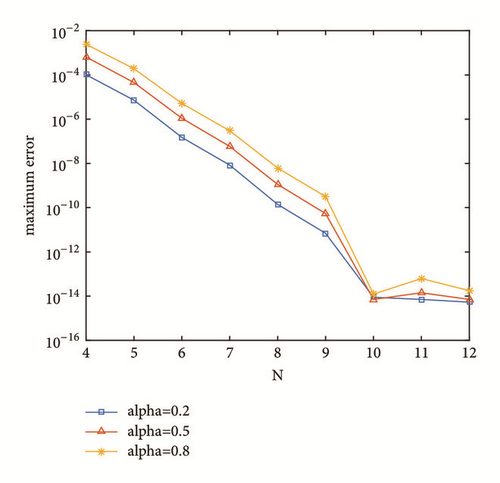
Example 27. In this example, we test the spectral approximation of Hadamard integral. Considering Hadamard-type fractional integral of y(x) = sin(πx) on the interval [1,2], when w(x) = 1 and α = 1, the Hadamard integral of y(x) is Sine integral function, Si(πx) − Si(π); for more general w(x) and α, the exact Hadamard-type integral of y(x) is unknown. Here we consider several pairs of w(x) and α. Numerical Hadamard-type integral of y(x) would be computed using (57) with z(x) = log(x). To evaluate the approximation accuracy, for the case w(x) = 1, α = 1, the exact Hadamard fractional integral is computed using MATLAB built-in function sinint; for other cases, “exact” Hadamard fractional integral is computed using (57) with large N (e.g., N = 50), which is treated as reference solution. The results for numerical Hadamard integral and approximation error are shown in Figures 2 and 3.
For this example u is not in the space for any n. Maximum error of approximated fractional integral converges exponentially until reaching machine accuracy.
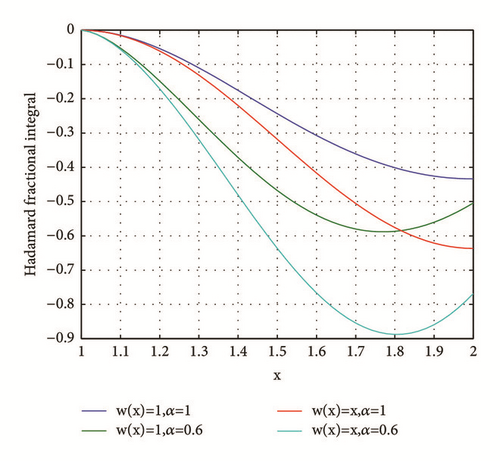
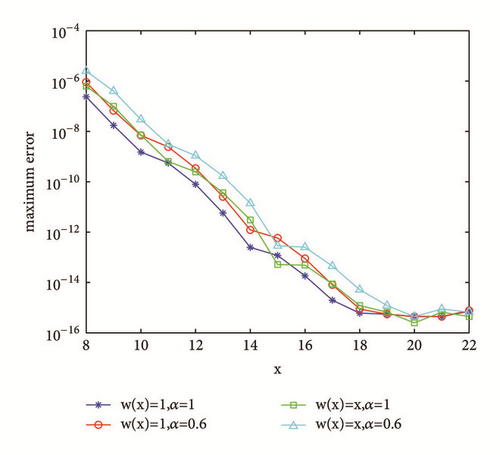
3.3. Fractional Integral/Differential Matrices
Theorem 28. For , vectors defined in (69)–(71), and matrices defined in (72)–(78), the following relation holds:
Proof. From the definition (69)–(71), (72)–(78), and (63)-(64), it is easy to obtain
From the definition of the interpolation function Lj(z),
Evaluating the matrices multiplication for each element, the following relation is derived:
Remark 29. Collocation points yj and the interpolation points xi are not necessary the same. To obtain a good approximation, interpolation points of Gauss-type are usually used. At the same time, collocation points should be chosen properly to guarantee stability properties of the method. In the following numerical examples, for computation and stability aim, both interpolation and collocation points are chosen based on Gauss-type points with respect to z(x).
4. Collocation Methods for Fractional Differential and Integral Equations
4.1. Fractional Ordinary Differential Equations
Considering the initial condition, we set with the first row replaced by (1,0, …, 0), F′ = F with its first element replaced by u0. Then the solution U is obtained by solving the matrix equation .
Example 30. Consider the following example:
The exact solution of the ordinary differential equation is u(x) = xr. Maximum absolute errors of numerical solutions for r = 6,7 and α = 0.3,0.6,0.9 are shown in Figures 4 and 5.
When z(x) = x2/3, w(x) = x, the scaled polynomial space becomes
For r = 7 the error converges exponentially and reaches machine accuracy at N = 12. It is faster than any finite difference method, while for r = 6 solution converges algebraically as N increases; however, it still reaches machine accuracy at N = 23. The major reason for this is that and for any .
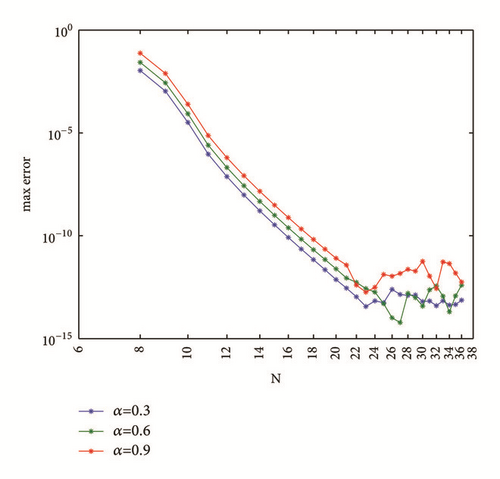
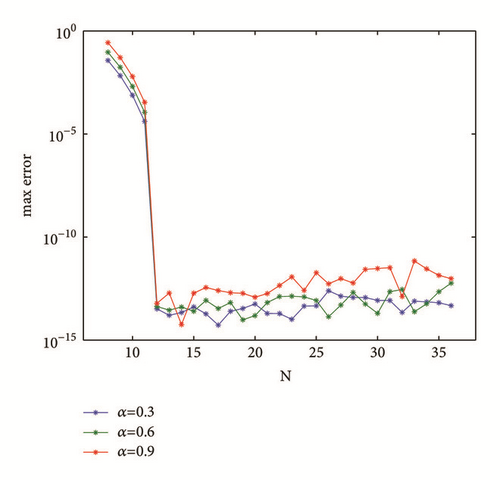
Remark 31. Since space is transformed from classical polynomial space with respect to z(x), the convergence of spectral collocation method for ODEs with generalized fractional operators depends not only on the smoothness of the solution itself, but also on the scale function z(t).
4.2. Hadamard-Type Integral Equations
In [42], Kilbas discussed the existence of the solution of (92). Explicit formulas for the solution f(t) were established in the following theorem.
Theorem 32 (see [42].)If xμg(x) ∈ AC[a, b], then the Hadamard-type integral equation (92) with 0 < α < 1 is solvable in Xμ(a, b) and its solution may be represented in the form
Example 33. Assume g(x) = sin(x − 1), μ = 1/3, Ω = [1,10]. Solutions of (92) for α = 0.3,0.6,0.9 are shown in Figure 6.
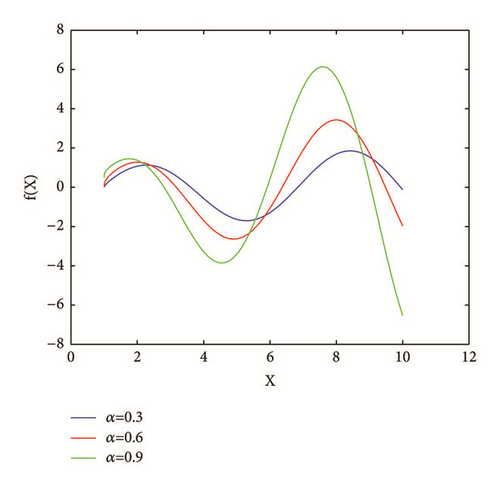
4.3. Erdélyi-Kober Fractional Diffusion Equation
Erdélyi-Kober fractional diffusion equation, which is also called stretched time-fractional diffusion equation, is the master equation of a kind of generalized grey Brownian motion (ggBm). The ggBm is a parametric class of stochastic processes that provides models for both fast and slow anomalous diffusion. This class is made up of self-similar processes Bα,β(t) with stationary increments and it depends on two real parameters: 0 < α ≤ 2 and 0 < β ≤ 1. It includes the fractional Brownian motion when 0 < α ≤ 2 and β = 1, the time-fractional diffusion stochastic processes when 0 < α = β < 1, and the standard Brownian motion when α = β = 1. About the relationship between stochastic process Bα,β(t) and stretched time-fractional diffusion equation, the following proposition is presented in [12].
Proposition 34. The marginal probability density function fα,β(x, t) of the process Bα,β(t), t ≥ 0, is the fundamental solution of the stretched time-fractional diffusion equation:
We use collocation method for both space and time discretization. We choose Legendre-Gauss-Lobatto (L-G-L) points xi (i = 0,1, …, M) as the space collocation points and choose tj (j = 0,1, …, N), such that z(tj) are L-G-L points, as the time collocation points.
Example 35. Assume x ∈ Ω = (−1,1), t ∈ (0,0.5], , u(·,t)|∂Ω = 0. Numerical solutions with M = N = 50 are shown in Figures 7–10.
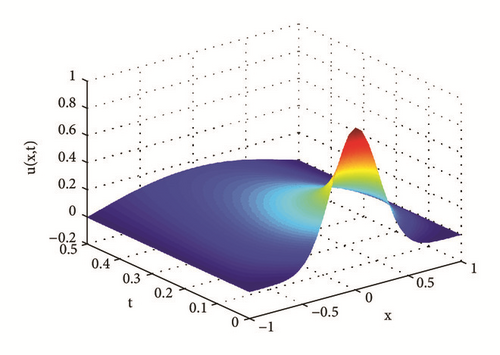
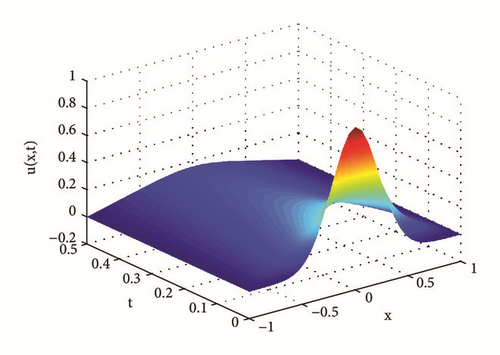
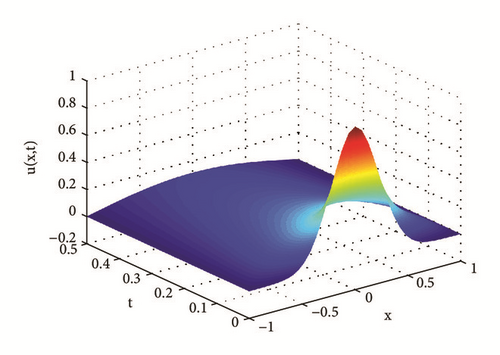
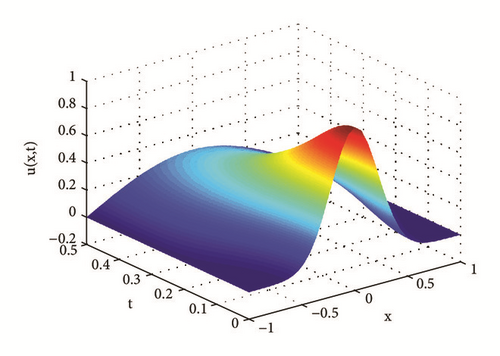
Erdélyi-Kober diffusion equation characterizes the marginal density function of the process Bα,β(t), t ≥ 0. When α = β = 1, we recover the standard diffusion equation. When 0 < α = β < 1, we get the time-fractional diffusion equation of order β. When β = 1 and 0 < α < 2, we have the equation of the fractional Brownian motion marginal density.
As shown in Figures 7 and 8, when 1 < α < 2, the diffusion is fast, and the increments exhibit long-range dependence; when 0 < α < 1, the diffusion is slow, and the increments form a stationary process which does not exhibit long-range dependence. The results coincide with theoretical analysis in [12, 14].
5. Conclusion
In this paper, we propose a spectral collocation method for differential and integral equations with generalized fractional operators. To deal with the difficulty in designing spectral approximation scheme due to complexity of integral kernel and weight, a variable transform technique is applied to the generalized fractional operator, and a spectral approximation method is proposed for the generalized fractional operator. Operational matrices for generalized fractional operators are derived. Spectral collocation methods are designed for fractional ordinary differential equations, Hadamard-type integral equations, and Erdélyi-Kober diffusion equations separately. Numerical experiments are carried out to verify the accuracy and efficiency of the method and characteristics of the Erdélyi-Kober diffusion equation are analyzed based on numerical results.
Disclosure
An earlier version of this work was presented at the “8th International Congress on Industrial and Applied Mathematics (ICIAM 2015)”.
Conflicts of Interest
The authors declare that they have no conflicts of interest.
Acknowledgments
The first author is supported by the National Key R&D Program of China (No. 2017YFC0209804), the National Science Foundation for Young Scientists of China (No. 11701273), and Youth Foundation of Jiangsu Province (No. BK20170628). The second author is supported by the National Key R&D Program of China (No. 2017YFB0305601).
Open Research
Data Availability
(i) The programs used to support the findings of this study have been deposited in the GitHub repository (https://github.com/qinwuxu/SpectralGFPDE ). (ii) No data were used to support this study.




